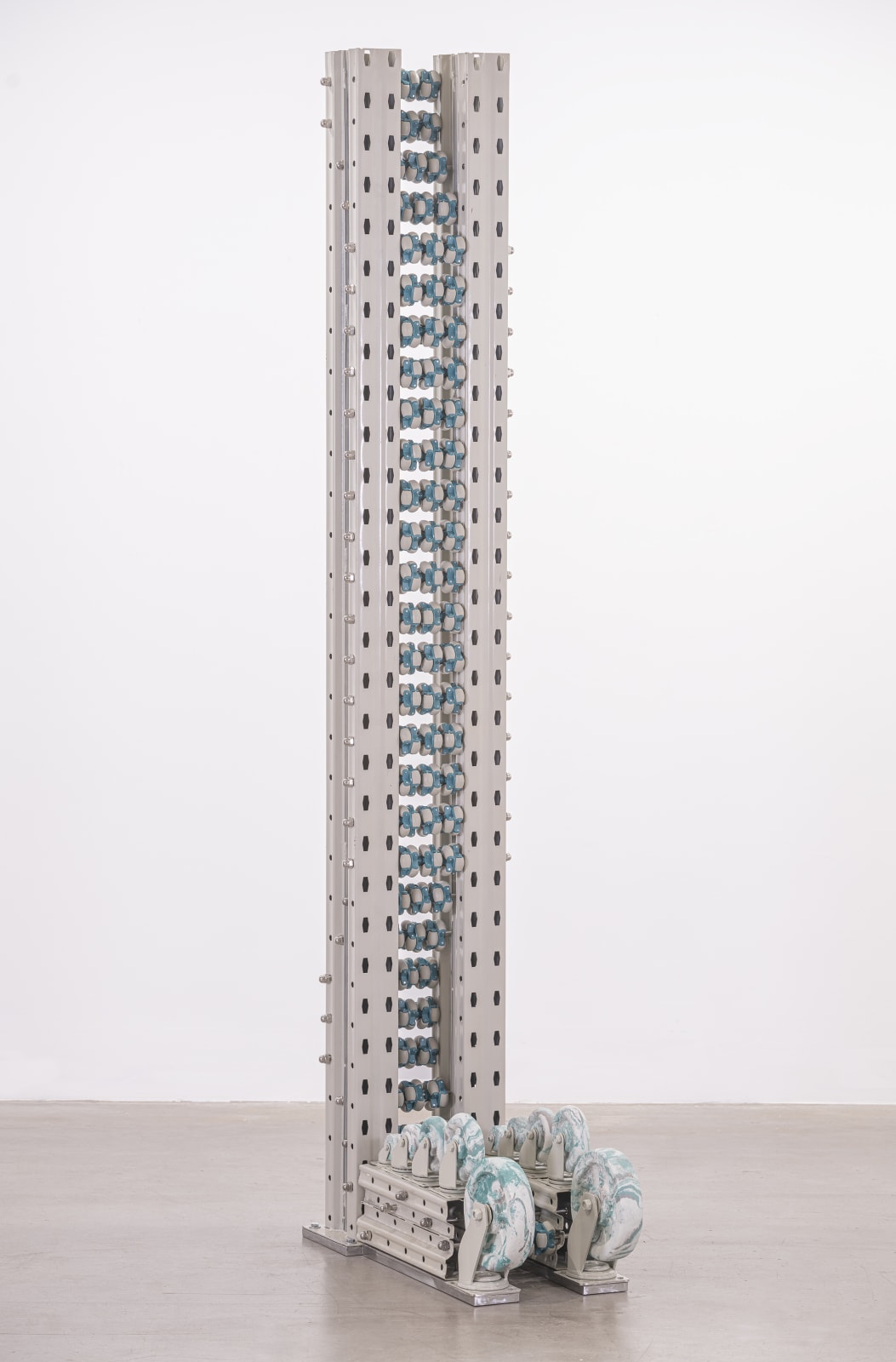Leelee Chan 陳麗同
Blindfold Receptor (willow-green) 蒙眼感知器(柳绿), 2019
metal columns, metal plate, stainless steel hardware, wheels, clay, spray paint 金属柱、金属板、不锈钢硬件、轮、黏土、喷漆
217.5 x 66.2 x 37.1 cm
85 1/2 x 26 x 14 1/2 in
85 1/2 x 26 x 14 1/2 in
Photo Courtesy: Blindspot Gallery 照片来源:刺点画廊
Blindfold Receptor is inspired by the camouflaging capabilities of the peppered-moth caterpillars. The peppered moth is a textbook example of Darwinian evolution through adaptation and natural selection. During the industrial revolution...
Blindfold Receptor is inspired by the camouflaging capabilities of the peppered-moth caterpillars. The peppered moth is a textbook example of Darwinian evolution through adaptation and natural selection. During the industrial revolution in the 1800s, light-colored moths evolved into a darker color after the trees in their habitat were darkened by soot. Now, due to rapid human changes to the environment, caterpillars could adapt even before they metamorphose into moths. Strikingly, they can mimic the colour of the branches they inhabit even when “blindfolded”, ie without using their eyes. Having evolved a mechanism to gain visual information about their surroundings, caterpillars can “see” with their skin and alter their colors accordingly. Their skin becomes at once a site of perception and transformation for tactile and visual data.
Receptor embodies Chan’s continuing exploration on the condition of co-existence between nature and human inhabitants in post-industrial urban environment. In a fantastic hybridity of industrial materials, she imagined that twigs and branches become metal columns reminiscent of the dense skyscrapers of Hong Kong, and the caterpillars morph into multiple-directional rollers (omni-wheel). Like the caterpillar’s variegated ways of ‘seeing’ and changing color, these omni-wheels evolved from a long lineage of wheels, dating back to the stone age, to move in all directions in smooth-rolling motions. Omni-wheels have since been widely adapted in robotics, manufacturing and logistics to improve productivity and efficiency.
《蒙眼感知器》的灵感来源于胡椒蛾毛毛虫的伪装技能。胡椒蛾是达尔文进化论中适应与自然选择的经典案例。在19世纪工业革命期间,由于栖息地的树木被烟尘熏黑,浅色的蛾逐渐进化为深色个体以更好地伪装。而在当今,人类活动导致环境急剧变化的背景下,毛毛虫甚至能在变成飞蛾之前就开始适应环境。更惊人的是,它们即便“蒙住眼睛”——也就是在不依赖视觉的情况下——依然可以模仿所处树枝的颜色。这些毛毛虫已经进化出一种通过皮肤获取视觉信息的机制,能够“以皮肤观色”,从而改变自身颜色。它们的皮肤成为了触觉与视觉信息的感知器与转化场。
感知器折射出陈丽同持续探索的主题——在后工业城市环境中,自然与人类如何共存。她将工业材料巧妙地糅合,将树枝和树干想象成金属立柱,形似香港密集的高楼,而毛毛虫则化身为万向轮。如同毛毛虫具有多样的视觉与变色机制,万向轮亦是从石器时代的车轮演变而来,能够朝各个方向顺滑滚动。如今,万向轮被广泛应用于机器人、制造业和物流领域,以提高效率与灵活性,成为人类适应环境、优化系统的又一进化路径。
Receptor embodies Chan’s continuing exploration on the condition of co-existence between nature and human inhabitants in post-industrial urban environment. In a fantastic hybridity of industrial materials, she imagined that twigs and branches become metal columns reminiscent of the dense skyscrapers of Hong Kong, and the caterpillars morph into multiple-directional rollers (omni-wheel). Like the caterpillar’s variegated ways of ‘seeing’ and changing color, these omni-wheels evolved from a long lineage of wheels, dating back to the stone age, to move in all directions in smooth-rolling motions. Omni-wheels have since been widely adapted in robotics, manufacturing and logistics to improve productivity and efficiency.
《蒙眼感知器》的灵感来源于胡椒蛾毛毛虫的伪装技能。胡椒蛾是达尔文进化论中适应与自然选择的经典案例。在19世纪工业革命期间,由于栖息地的树木被烟尘熏黑,浅色的蛾逐渐进化为深色个体以更好地伪装。而在当今,人类活动导致环境急剧变化的背景下,毛毛虫甚至能在变成飞蛾之前就开始适应环境。更惊人的是,它们即便“蒙住眼睛”——也就是在不依赖视觉的情况下——依然可以模仿所处树枝的颜色。这些毛毛虫已经进化出一种通过皮肤获取视觉信息的机制,能够“以皮肤观色”,从而改变自身颜色。它们的皮肤成为了触觉与视觉信息的感知器与转化场。
感知器折射出陈丽同持续探索的主题——在后工业城市环境中,自然与人类如何共存。她将工业材料巧妙地糅合,将树枝和树干想象成金属立柱,形似香港密集的高楼,而毛毛虫则化身为万向轮。如同毛毛虫具有多样的视觉与变色机制,万向轮亦是从石器时代的车轮演变而来,能够朝各个方向顺滑滚动。如今,万向轮被广泛应用于机器人、制造业和物流领域,以提高效率与灵活性,成为人类适应环境、优化系统的又一进化路径。


